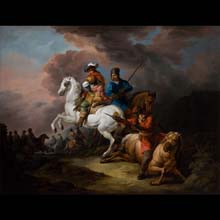
material: oil on canvas
dimensions: 86,8 cm 113 cm
description: The painting by Jan Bogumił Plersch is not characteristic of the oeuvre of this artist, who at the court of King Stanisław August became famous for his frescos – decorations of the rooms in the royal palaces, as well as theatre sceneries and occasional paintings. He very rarely did history and battle scene paintings. Yet, he painted, e.g., scenes from the Kościuszko Uprising. Battle Scene was inspired by French painting, especially the war episodes painted by Francesco Giuseppe Casanova, an Italian artist operating in France, whose paintings enjoyed popularity in the 18th century. His fame reached even Saint Petersburg. Actually, some of his students arrived to his studio from this city. Although he did not study in France, Plersch knew the oeuvre of Casanova well. The composition of his works resembled that of Casanova, and he also employed the favourite motifs of this artist. The central group, depicted in the foreground, consisting of figures involved in the event, are horse riders. One of them is usually mounted on a white horse. In the background, there is a remote, open landscape with tumbling clouds. It is worthy of note that contrary to Casanova, despite considerable dynamism of the painting, Plersch did not illustrate the fight, but the march of troops. Barbara Ciciora
exposition: The Gallery of 19th Century Polish Art in Sukiennice,
The Cloth Hall, 1, Main Market Square
key: Enlightenment >>>
dimensions: 86,8 cm 113 cm
description: The painting by Jan Bogumił Plersch is not characteristic of the oeuvre of this artist, who at the court of King Stanisław August became famous for his frescos – decorations of the rooms in the royal palaces, as well as theatre sceneries and occasional paintings. He very rarely did history and battle scene paintings. Yet, he painted, e.g., scenes from the Kościuszko Uprising. Battle Scene was inspired by French painting, especially the war episodes painted by Francesco Giuseppe Casanova, an Italian artist operating in France, whose paintings enjoyed popularity in the 18th century. His fame reached even Saint Petersburg. Actually, some of his students arrived to his studio from this city. Although he did not study in France, Plersch knew the oeuvre of Casanova well. The composition of his works resembled that of Casanova, and he also employed the favourite motifs of this artist. The central group, depicted in the foreground, consisting of figures involved in the event, are horse riders. One of them is usually mounted on a white horse. In the background, there is a remote, open landscape with tumbling clouds. It is worthy of note that contrary to Casanova, despite considerable dynamism of the painting, Plersch did not illustrate the fight, but the march of troops. Barbara Ciciora
exposition: The Gallery of 19th Century Polish Art in Sukiennice,
The Cloth Hall, 1, Main Market Square
key: Enlightenment >>>












